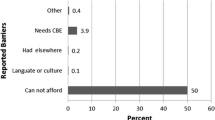Abstract
Latina women continue to face disproportionate breast cancer risk and well-documented breast health care barriers in Philadelphia. In response to breast health needs among Latinas in Philadelphia, a health-focused community-based organization, in partnership with a network of social and health service providers, began offering community-based navigation in 2005. Later, through funding from a federal agency, the organization launched the Naveguemos con Salud (NCS) Breast Health Partnership Project from 2010 to 2013. NCS offered breast health awareness and education to a broad audience of Latinas in Philadelphia and community-based navigation services to all interested in accessing a clinical breast exam (CBE) and/or mammogram. A 2017 survey revisited breast health needs among the same core population to inform next steps. Here, we explore how findings and lessons learned from a past program and an assessment of current needs can inform future community-clinical linkage and community-based navigation to improve access to breast cancer screening and a continuum of care for Latinas.
Similar content being viewed by others
Notes
Institutional review board [IRB] determination—exempt/non-research; PHMC IRB#00002451; PHMC FWA#00002489.
References
American Cancer Society (2015) Cancer facts and figures for Hispanics/Latinos 2015-2017. Atlanta: American Cancer Society. https://www.cancer.org/content/dam/cancer-org/research/cancer-facts-and-statistics/cancer-facts-and-figures-for-hispanics-and-latinos/cancer-facts-and-figures-for-hispanics-and-latinos-2015-2017.pdf. Accessed 22 Jan 2018
Freeman HP, Rodriguez RL (2011) History and principles of patient navigation. Cancer 117:3537–3540. https://doi.org/10.1002/cncr.26262
American Cancer Society (2017) American Cancer Society guidelines for the early detection of cancer. https://www.cancer.org/healthy/find-cancer-early/cancer-screening-guidelines/american-cancer-society-guidelines-for-the-early-detection-of-cancer.html. Accessed 27 June 2017
Ward E, Halpern M, Schrag N, Cokkinides V, DeSantis C, Bandi P, Siegel R, Stewart A, Jemal A (2008) Association of insurance with cancer care utilization and outcomes. CA Cancer J Clin 58:9–31. https://doi.org/10.3322/CA.2007.0011
Otero-Sabogal R, Owens D, Canchola J, Golding JM, Tabnak F, Fox P (2004) Mammography rescreening among women of diverse ethnicities: patient, provider, and health care system factors. J Health Care Poor Underserved 15:390–412. https://doi.org/10.1353/hpu.2004.0048
Timmins C (2002) The impact of language barriers on the health care of Latinos in the United States: a review of the literature and guidelines for practice. J Midwif Women’s Health 47(2):80–96
Abouzaid S, Maio V (2009) The inequality in health care quality. Am J Med Qual 24:182–184. https://doi.org/10.1177/1062860609334172
Bickell NA, Shastri K, Fei K et al (2008) A tracking and feedback registry to reduce racial disparities in breast cancer care. J Natl Cancer Inst. https://doi.org/10.1093/jnci/djn387
Natale-Pereira A, Enard KR, Nevarez L, Jones LA (2011) The role of patient navigators in eliminating health disparities. Cancer 117:3541–3550. https://doi.org/10.1002/cncr.26264
Donaldson EA, Holtgrave DR, Duffin RA, Feltner F, Funderburk W, Freeman HP (2012) Patient navigation for breast and colorectal cancer in 3 community hospital settings. Cancer 118:4851–4859. https://doi.org/10.1002/cncr.27487
Drake BF, Tannan S, Anwuri VV, Jackson S, Sanford M, Tappenden J, Goodman MS, Colditz GA (2015) A community-based partnership to successfully implement and maintain a breast health navigation program. J Community Health 40:1216–1223. https://doi.org/10.1007/s10900-015-0051-z
Freund KM, Battaglia TA, Calhoun E et al (2014) Impact of patient navigation on timely cancer care: the Patient Navigation Research Program. J Natl Cancer Inst. https://doi.org/10.1093/jnci/dju115
Charlot M, Christina Santana M, Chen CA et al (2015) Impact of patient and navigator race and language concordance on care after cancer screening abnormalities. Cancer 121:1477–1483. https://doi.org/10.1002/cncr.29221
Ell K, Vourlekis B, Lee P-J (2007) Patient navigation and case management following an abnormal mammogram: a randomized clinical trial. Prev Med 44:26–33. https://doi.org/10.1016/j.ypmed.2006.08.001
Jean-Pierre P, Hendren S, Fiscella K, Loader S, Rousseau S, Schwartzbauer B, Sanders M, Carroll J, Epstein R (2011) Understanding the processes of patient navigation to reduce disparities in cancer care: perspectives of trained navigators from the field. J Cancer Educ 26:111–120. https://doi.org/10.1007/s13187-010-0122-x
Public Health Management Corporation (2015) Community Health Data Base, Southeastern Pennsylvania Household Health Survey. http://www.chdbdata.org/data-data-tools. Accessed 22 Jan 2018
Harold P. Freeman Patient Navigation Institute. 2018. Our model: the gold standard. www.hpfreemanpni.org/our-model/. Accessed 22 Jan 2018
National Cancer Institute (2015) Patient Navigation Research Program (PNRP). www.cancer.gov/about-nci/organization/crchd/disparities-research/pnrp. Accessed 22 Jan 2018
Centers for Disease Control and Prevention (2016) Health equity: promotores de salud / community health workers. https://www.cdc.gov/minorityhealth/promotores/index.html. Accessed 22 Jan 2018
Acknowledgements
The authors would like to thank LCDR Ieshia K. Jones for her leadership during Naveguemos con Salud. Additional gratitude to the dedicated and talented navigation team at Health Promotion Council, with special thanks to Marla Vega, Maria Barrera, Elizabeth Rosario, and the full Breast Health Navigation Network.
Funding
NCS was funded by a grant from the US Department of Health and Human Services (HHS) Office of Minority Health (CPIMP101062) with additional support from Susan G. Komen for the Cure. Follow-up survey support was provided by and the Breast Cancer Work Group via the Pennsylvania Department of Health. This publication was supported by Grant Number 5U58DP003937-05, funded by the Centers for Disease Control and Prevention. Its contents are solely the responsibility of the authors and do not necessarily represent the official views of the Centers for Disease Control and Prevention, the Department of Health and Human Services, or other funders.
Author information
Authors and Affiliations
Corresponding author
Ethics declarations
Human and Animal Rights and Informed Consent
This article does not contain any studies with human participants or animals performed by any of the authors.
Rights and permissions
About this article
Cite this article
Keith, J.D., Kang, N.E., Bodden, M. et al. Supporting Latina Breast Health with Community-based Navigation. J Canc Educ 34, 654–657 (2019). https://doi.org/10.1007/s13187-018-1351-7
Published:
Issue Date:
DOI: https://doi.org/10.1007/s13187-018-1351-7



